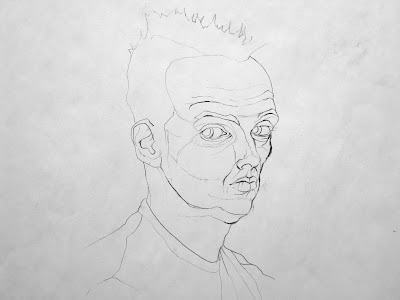Perugino, The Delivery of the Keys, 1481–1482, Sistine Chapel, Rome.
To juxtapose Perugino's Delivery Of The Keys and Reinhardt's Abstract Painting may seem rather like going from the sublime to the ridiculous. But as we shall see, this is far from the case. Perugino constructed his depth mathematically, using the newly developed Renaissance system known as perspective. Reinhardt paints what seems to be, on first glance, an all black canvas. Perugino ensures that the surfaces of objects follow a horizontal and vertical alignment and recess diagonally "into" the picture plane. We can thus locate them positionally at left, right, above, and below, as well as in the foreground, middle-distance, or background. And then, by lighting his surfaces positively and employing a full range of color values, he cannot fail to render objects as solid and as quite distinctly positioned in space. Therefore, as in sculpture which is treated substantially, the clear presence and positioning of physical surfaces articulates space in the painting and we become aware of time and distance.

Ad Reinhardt, Abstract Painting, 1963. Oil on canvas, 60 x 60"
In start contrast, Reinhardt's canvas brings us back to consider Thomas Mann's "vast plain of empty sea," for it is an image that justifies description as minimal. It is difficult to perceive any positive form or figure on the ground of the canvas and the only articulation of space is provided by the faint color variations of black. The question then arises: "Do we see this as a painting of a more or less solid form completely blotting out space – like the side of a wall for example – or as a spatial void defined only by the sides of the canvas?" In seeing Reinhardt next to Perugino, some readers will be wondering what has happened to pictorial art – what kind of development after 500 post-Renaissance years does the contemporary image represent? …
Obviously I am not out to make any value-judgment comparisons between Reinhardt and Perugino, for this would be both impossible and ridiculous. Instead, I am concerned with showing a traditional attitude toward spatial problems in painting alongside a rather extreme contemporary one. For a number of years now, subject matter as such has not been of major importance for many artists. Yet even if we recognize this fact, Reinhardt's "nothingness" goes a step further. As an image it is almost formless, spaceless, and therefore timeless. Because of this lack of features, the viewer is forced to look hard to try to discover more of what he feels must be there. After all, it is a painting and the eye does not like to be thwarted. Even so it yields little save the slight presence of a cross motif. Other thoughts then come to mind, for a minimal image challenges the observer's imagination to make of it what he will. There is something hypnotic about about such a neutral, ambiguous, minimal work. In my opinion, its dark and vague pictorial surface invites contemplation. After the visual confusion and clutter of our cities, the noise and the killing pace of modern life, such quiet emptiness can come as a great relief.
Again, it has been said that ours is an age of apathy, when noninvolvement and non-commitment are the order of the day. Bearing this in mind it is possible to regard the bleakness of Reinhardt's image as symbolizing our loss of sensibility in those areas of commitment which are the particular prerogative of human beings; namely, an ability to respond to natural things with feeling and respect… to believe in love and commitment as principles in themselves, and to cultivate and trust one's values. These are but a few examples. To be more cynical and perhaps less perceptive, it may be said that the painting is a painting of nothing and means nothing – after all, an image cannot be any more minimal than that.
—
Graham Collier - Art & The Creative Consciousness

.jpg)


%20-drawing_detail1494.jpg)